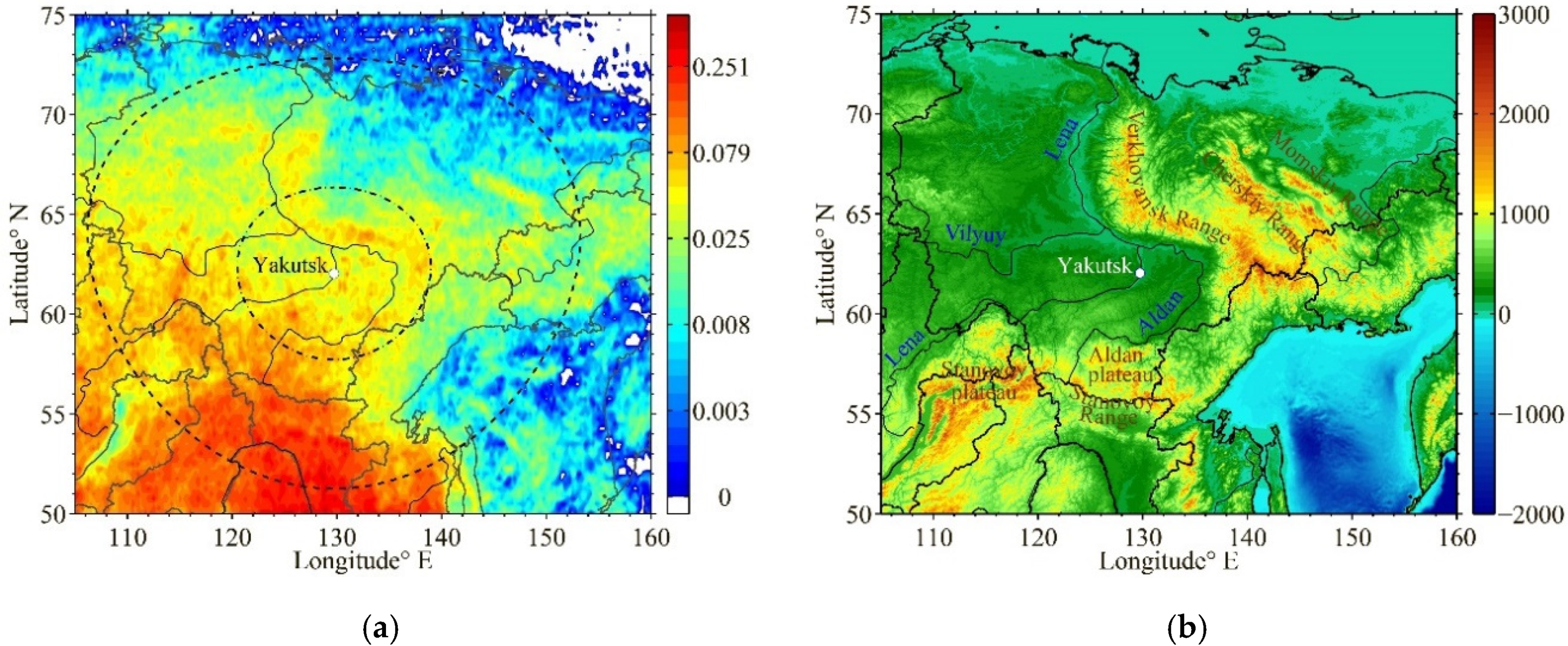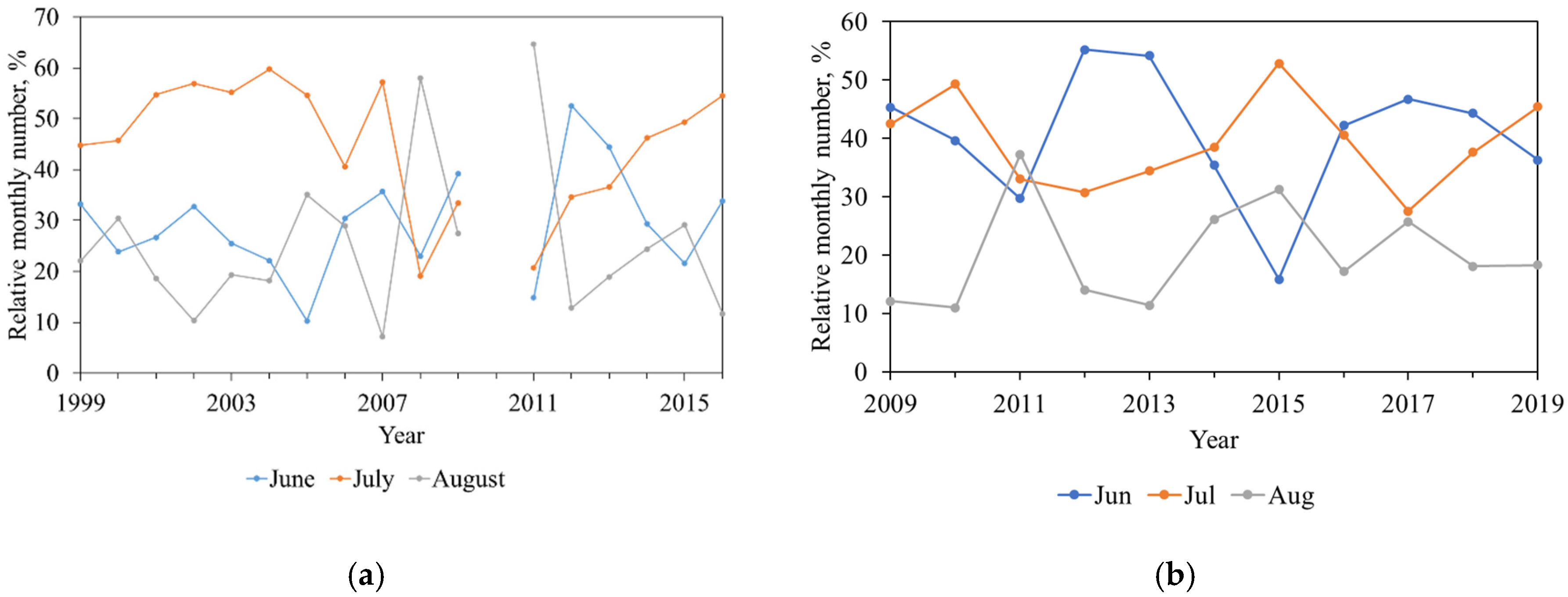Seasonal Variability of Lightning Activity in Yakutia in 2009–2019
Abstract
1. Introduction
2. Instrumentation
2.1. Lightning Direction Finder
2.2. Stormtracker Detector
2.3. World Wide Lightning Location Network
3. Results
3.1. The Yakutia Region
3.1.1. Mean Lightning Density
3.1.2. Annual Variation of Total Lightning Stroke Number
3.1.3. Seasonal Variations
3.2. Central Yakutia
3.2.1. Lightning Activity Seasons’ Beginning and Ending
3.2.2. Seasonal Variation in Central Yakutia
3.2.3. Preliminary Comparison with Average Wind Direction
3.2.4. Ratio of Number of Common Lightning Types to the Total Lightning Number
4. Discussion
5. Conclusions
Author Contributions
Funding
Acknowledgments
Conflicts of Interest
References
- Filippov, A.K. Thunderstorms of Eastern Siberia; Hydrometeoizdat: Leningrad, Russia, 1974; p. 75. [Google Scholar]
- Filippov, A.K.; Khutyoryanskaya, D.F. Statistical characteristics of thunderstorms in Yakutia. Rep. Inst. Geogr. Sib. Far East 1971, 31, 39–47. [Google Scholar]
- Kozlov, V.I.; Mullayarov, V.A. Instrumental observations of thunderstorm activity in Yakutia in 1993–1994. Russ. Meteorol. Hydrol. 1996, 2, 105–109. [Google Scholar]
- Kozlov, V.I.; Mullayarov, V.A.; Laptev, A.D.; Valkov, S.P.; Gromov, B.N. Detecting thunderstorm activity in Yakutiya by means of one-site thunderstorm direction-range finder. Izv. Atmos. Ocean. Phys. 1996, 32, 199–204. [Google Scholar]
- Kozlov, V.I.; Mullayarov, V.A. Lightning Activity in Yakutia; YaSC SB RAS: Yakutsk, Russia, 2004; p. 103. [Google Scholar]
- Cecil, D.J.; Buechler, D.E.; Blakeslee, R.J. Gridded lightning climatology from TRMM-LIS and OTD: Dataset description. Atmos. Res. 2014, 135, 404–414. [Google Scholar] [CrossRef]
- Moskovenko, V.M.; Znamenschikov, B.P.; Zolotarev, S.V. Application of the Vereya-MR lightning direction finding system in the interests of the Russian power industry. New Russ. Electr. Power Ind. 2012, 2, 15–23. [Google Scholar]
- McGee, T.; McFarlane, B.; Tymstra, C. Wildfire: A Canadian perspective. In Wildfire Hazards, Risks and Disasters; Shroder, J.F., Paton, D., Eds.; Elsevier: Amsterdam, The Netherlands, 2015; pp. 35–58. [Google Scholar] [CrossRef]
- Veraverbeke, S.; Rogers, B.; Goulden, M.; Jandt, R.R.; Miller, C.E.; Wiggins, E.B.; Randerson, J.T. Lightning as a major driver of recent large fire years in North American boreal forests. Nat. Clim. Chang. 2017, 7, 529–534. [Google Scholar] [CrossRef]
- The Ministry of the Russian Federation for Civil Defence, Emergencies and Elimination of Consequences of Natural Disasters. Available online: https://14.mchs.gov.ru/deyatelnost/poleznaya-informaciya/dopolnitelnye-stranicy/konstruktor-blokov/pravaya-kolonka/intervyu/1749024 (accessed on 30 July 2020).
- Tomshin, O.A.; Solovyev, V.S. Detection of burnt areas in Yakutia on long-term NOAA satellites data (1985–2015). In Proceedings of the 24th International Symposium on Atmospheric and Ocean Optics: Atmospheric Physics, Tomsk, Russia, 2–5 July 2018; Matvienko, G.G., Romanovskii, O.A., Eds.; SPIE: Bellingham, WA, USA, 2018; Volume 10833. [Google Scholar] [CrossRef]
- Reeve, N.; Toumi, R. Lightning activity as an indicator of climate change. Q. J. R. Meteorol. Soc. 1999, 125, 893–903. [Google Scholar] [CrossRef]
- Yijun, Z.; Ming, M.; Weitao, L.U.; Shanchang, T.A.O. Review on climate characteristics of lightning activity. J. Meteorol. Res. 2010, 24, 137–149. [Google Scholar]
- Avila, E.E.; Bürgesser, R.E.; Castellano, N.E.; Collier, A.B.; Compagnucci, R.H.; Hughes, A.R. Correlations between deep convection and lightning activity on a global scale. J. Atmos. Sol. Terr. Phys. 2010, 72, 1114–1121. [Google Scholar] [CrossRef]
- Teufel, B.; Sushama, L. Abrupt changes across the Arctic permafrost region endanger northern development. Nat. Clim. Chang. 2019, 9, 858–862. [Google Scholar] [CrossRef]
- Dowden, R.L.; Brundell, J.B.; Rodger, C.J. VLF lightning location by time of group arrival (TOGA) at multiple sites. J. Atmos. Sol. Terr. Phys. 2002, 64, 817–830. [Google Scholar] [CrossRef]
- Hutchins, M.L.; Holzworth, R.H.; Rodger, C.J.; Brundell, J.B. Far-field power of lightning strokes as measured by the World Wide Lightning Location Network. J. Atmos. Ocean. Technol. 2012, 29, 1102–1110. [Google Scholar] [CrossRef]
- Saba, M.M.F.; Ballarotti, M.; Pinto, O., Jr. Negative cloud-to-ground lightning properties from high-speed video observations. J. Geophys. Res. Atmos. 2006, 111, D03101. [Google Scholar] [CrossRef]
- Rakov, V.A.; Huffines, G.R. Return stroke multiplicity of negative cloudtoground lightning flashes. J. Appl. Meteorol. 2003, 42, 1455–1462. [Google Scholar] [CrossRef]
- Tarabukina, L.D.; Kozlov, V.I. Parameters of radio pulses of cloud-to-ground multiple-stroke lightning discharges in Northeast Asia. Izv. Atmos. Ocean. Phys. 2016, 52, 271–276. [Google Scholar] [CrossRef]
- Nag, A.; Rakov, V.; Schulz, W.; Saba, M.M.F.; Thottappillil, R.; Biagi, C.J.; Filho, A.O.; Kafri, A.; Theethayi, N.; Götschl, T. First versus subsequent return-stroke current and field peaks in negative cloud-to-ground lightning discharges. J. Geophys. Res. Atmos. 2008, 113, D19112. [Google Scholar] [CrossRef]
- Li, Q.; Li, K.; Chen, X. Research on lightning electromagnetic fields associated with first and subsequent return strokes based on Laplace wavelet. J. Atmos. Sol. Terr. Phys. 2013, 93, 1–10. [Google Scholar] [CrossRef]
- Kozlov, V.I.; Mullayarov, V.A.; Vasiliev, A.E. Characteristics of thunderstorm cores in Yakutia in 1993–2001 from instrumental observations. Russ. Meteorol. Hydrol. 2003, 2, 39–45. [Google Scholar]
- Kozlov, V.I.; Mullayarov, V.A.; Karimov, R.R. Tool measurements of thunderstorms in Yakutia in 2003–2006. Radiophys. Quantum Electron. 2008, 51, 745–749. [Google Scholar] [CrossRef]
- Astrogenic Systems. Available online: https://www.astrogenic.com/nexstorm_lite.html (accessed on 8 August 2020).
- Kozlov, V.I.; Markova, A.; Shabaganova, S.N. Errors of methods of one and two points locating the lightning discharge system. Nauka Obraz. 2010, 1, 7–12. [Google Scholar]
- World Wide Lightning Location Network. Available online: wwlln.net (accessed on 8 August 2020).
- Rodger, C.J.; Werner, S.; Brundell, J.B.; Lay, E.H.; Thomson, N.R.; Holzworth, R.H.; Dowden, R.L. Detection efficiency of the VLF World-Wide Lightning Location Network (WWLLN): Initial case study. Ann. Geophys. 2006, 24, 3197–3214. [Google Scholar] [CrossRef]
- De Souza, P.; Pinto, O., Jr.; Pinto, I.; Ferreira, N.; Dos Santos, A.F. The intracloud/cloud-to-ground lightning ratio in Southeastern Brazil. Atmos. Res. 2009, 91, 491–499. [Google Scholar] [CrossRef]
- Soriano, L.R.; de Pablo, F. Total flash density and the intracloud/cloud-to-ground lightning ratio over the Iberian Peninsula. J. Geophys. Res. Atmos. 2007, 112, D13114. [Google Scholar] [CrossRef]
- Adzhiev, A.H.; Kuliev, D.D. Characteristics of Storm Activity and Parameters of Lightning Discharges in the South of the European Part of Russia. Izv. Atmos. Ocean. Phys. 2018, 54, 372–379. [Google Scholar] [CrossRef]
- Rudlosky, S.D.; Shea, D.T. Evaluating WWLLN performance relative to TRMM/LIS. Geophys. Res. Lett. 2013, 40, 2344–2348. [Google Scholar] [CrossRef]
- Bürgesser, R.E. Assessment of the World Wide Lightning Location Network (WWLLN) detection efficiency by comparison to the Lightning Imaging Sensor (LIS). Q. J. R. Meteorol. Soc. 2017, 143, 2809–2817. [Google Scholar] [CrossRef]
- Abarca, S.F.; Corbosiero, K.L.; Galarneau, T.J. An evaluation of the Worldwide Lightning Location Network (WWLLN) using the National Lightning Detection Network (NLDN) as ground truth. J. Geophys. Res. Atmos. 2010, 115, D18206. [Google Scholar] [CrossRef]
- Holzworth, R.H.; McCarthy, M.P.; Brundell, J.B.; Jacobson, A.R.; Rodger, C.J. Global Distribution of Superbolts. J. Geophys. Res. Atmos. 2019, 124, 9996–10005. [Google Scholar] [CrossRef]
- Hutchins, M.L.; Holzworth, R.H.; Brundell, J.B.; Rodger, C.J. Relative detection efficiency of the World Wide Lightning Location Network. Radio Sci. 2012, 47, 1–9. [Google Scholar] [CrossRef]
- EOSDIS Worldview. Available online: https://worldview.earthdata.nasa.gov (accessed on 8 August 2020).
- Amante, C.; Eakins, B.W. ETOPO1 1 Arc-Minute Global Relief Model: Procedures, Data Sources and Analysis. NOAA Technical Memorandum NESDIS NGDC-24; National Geophysical Data Center, NOAA: Boulder, CO, USA, 2009. [Google Scholar] [CrossRef]
- Schwer, C.A.; Izyumenko, S.A. The Climate of Yakutsk; Hydrometeoizdat: Leningrad, Russia, 1982; 246p. [Google Scholar]
- Kozlov, V.I.; Mullayarov, V.A.; Shabaganova, S.N. Characteristics of thunderstorm cores from observations in Yakutia. Russ. Phys. J. 2013, 56, 398–404. [Google Scholar] [CrossRef]
- Bourscheidt, V.; Junior, O.P.; Naccarato, K.P.; Pinto, I.R.C.A. The influence of topography on the cloud-to-ground lightning density in South Brazil. Atmos. Res. 2009, 91, 508–513. [Google Scholar] [CrossRef]
- Kilinc, M.; Beringer, J. The Spatial and Temporal Distribution of Lightning Strikes and Their Relationship with Vegetation Type, Elevation, and Fire Scars in the Northern Territory. J. Clim. 2007, 20, 1161–1173. [Google Scholar] [CrossRef]
- Kotroni, V.; Lagouvardos, K. Lightning occurrence in relation with elevation, terrain slope, and vegetation cover in the Mediterranean. J. Geophys. Res. Atmos. 2008, 113, D21118. [Google Scholar] [CrossRef]
- Tarabukina, L.D.; Kozlov, V.I.; Karimov, R.R.; Mullayarov, V.A. Spatial pattern of lightning strikes in North Asia. Russ. Meteorol. Hydrol. 2017, 42, 88–94. [Google Scholar] [CrossRef]
- Oulkar, S.; Siingh, D.; Saha, U.; Kamra, A.K. Distribution of lightning in relation to topography and vegetation cover over the dry and moist regions in the Himalayas. J. Earth Syst. Sci. 2019, 128, 180. [Google Scholar] [CrossRef]
- Tarabukina, L.D.; Kozlov, V.I. Spatial and temporal distribution of lightning strokes over north Asia and its comparison with solar activity variations in 2009–2016. Sol. Terr. Phys. 2017, 3, 65–69. [Google Scholar] [CrossRef][Green Version]
- Latysheva, I.V.; Loshenko, K.A.; Shahaeva, E.V.; Smetanin, G.S. The circulation characteristics of anomalous weather phenomena on the territory of Russia in the summer of 2013. The Bulletin of Irkutsk State University. Ser. Earth Sci. 2013, 6, 125–137. [Google Scholar]
- Romps, D.M.; Seeley, J.T.; Vollaro, D.; Molinari, J. Projected increase in lightning strikes in the United States due to global warming. Science 2014, 346, 851–854. [Google Scholar] [CrossRef]
- Dewan, A.; Ongee, E.T.; Rafiuddin, M.; Rahman, M.M.; Mahmood, R. Lightning activity associated with precipitation and CAPE over Bangladesh. Int. J. Clim. 2018, 38, 1649–1660. [Google Scholar] [CrossRef]
- Pineda, N.; Rigo, T.; Bech, J.; Soler, X. Lightning and precipitation relationship in summer thunderstorms: Case studies in the North Western Mediterranean region. Atmos. Res. 2007, 85, 159–170. [Google Scholar] [CrossRef]
- Ray, P.S.; MacGorman, D.R.; Rust, W.D.; Taylor, W.L.; Rasmussen, L.W. Lightning location relative to storm structure in a supercell storm and a multicell storm. J. Geophys. Res. Atmos. 1987, 92, 5713–5724. [Google Scholar] [CrossRef]
- Mecikalski, R.M.; Carey, L.D. Lightning characteristics relative to radar, altitude and temperature for a multicell, MCS and supercell over northern Alabama. Atmos. Res. 2017, 191, 128–140. [Google Scholar] [CrossRef]
- Kaltenboeck, R.; Steinheimer, M. Radar-based severe storm climatology for Austrian complex orography related to vertical wind shear and atmospheric instability. Atmos. Res. 2015, 158, 216–230. [Google Scholar] [CrossRef]
- Nag, A.; Rakov, V. Positive lightning: An overview, new observations, and inferences. J. Geophys. Res. Atmos. 2012, 117, D08109. [Google Scholar] [CrossRef]
- Nag, A.; Rakov, V.; Cummins, K.L. Positive Lightning Peak Currents Reported by the U.S. National Lightning Detection Network. IEEE Trans. Electromagn. Compat. 2013, 56, 404–412. [Google Scholar] [CrossRef]
- Tarabukina, L.; Kozlov, V.; Innokentiev, D. Assessment of Lightning Parameters during Thunderstorm Development in Yakutia. In Proceedings of the 2019 Russian Open Conference on Radio Wave Propagation (RWP), Kazan, Russia, 1–6 July 2019; IEEE: Piscataway, NJ, USA, 2019; pp. 564–567. [Google Scholar]










| Year | Number of Days without Recordings | Outages, % | Dates with Maximum Outages Duration |
|---|---|---|---|
| 2009 | 7 | 7.6 | 4–10 June |
| 2010 | 14 | 15.2 | 15–28 July |
| 2011 | 6 | 6.5 | 21–26 July |
| 2012 | 2 | 2.2 | 27–28 July |
| 2013 | 7 | 7.6 | 15–21 August |
| 2014 | 7 | 7.6 | 7–13 August |
| 2015 | 0 | 0 | |
| 2016 | 0 | 0 |
© 2020 by the authors. Licensee MDPI, Basel, Switzerland. This article is an open access article distributed under the terms and conditions of the Creative Commons Attribution (CC BY) license (http://creativecommons.org/licenses/by/4.0/).
Share and Cite
Tarabukina, L.; Kozlov, V. Seasonal Variability of Lightning Activity in Yakutia in 2009–2019. Atmosphere 2020, 11, 918. https://doi.org/10.3390/atmos11090918
Tarabukina L, Kozlov V. Seasonal Variability of Lightning Activity in Yakutia in 2009–2019. Atmosphere. 2020; 11(9):918. https://doi.org/10.3390/atmos11090918
Chicago/Turabian StyleTarabukina, Lena, and Vladimir Kozlov. 2020. "Seasonal Variability of Lightning Activity in Yakutia in 2009–2019" Atmosphere 11, no. 9: 918. https://doi.org/10.3390/atmos11090918
APA StyleTarabukina, L., & Kozlov, V. (2020). Seasonal Variability of Lightning Activity in Yakutia in 2009–2019. Atmosphere, 11(9), 918. https://doi.org/10.3390/atmos11090918





